
©
Dubbed The Golden State, California is a land rich in natural beauty. It’s home to a diverse array of creatures including cougars, beavers, and black bears, and its waters team with an abundance of marine mammals such as whales and dolphins. The state is also home to an assortment of common and unique spiders. From garden-variety orb weavers to rare tarantulas, there are many different spiders in California. Here are 10 different spiders in California that you may encounter if you spend time in the state.
#10: Hacklemesh Weaver

The hacklemesh weaver is sometimes confused with the brown recluse, although it is not nearly as dangerous.
©Eric Isselee/Shutterstock.com
The hacklemesh weaver is a member of the family Amaurobiidae. While many species in its family are native to Australia, you can also find these spiders in California and scattered throughout the southern United States.
Generally speaking, most hacklemesh weavers measure between 6 and 11 millimeters in length. Their abdomen is predominantly dark brown or tan and its carapace and legs are reddish-brown. People sometimes confuse the hacklemesh weaver with the brown recluse, but it lacks the latter spider’s distinctive violin-shaped marking.
The hacklemesh weaver gets its name from the mesh-like shape of its web. Unlike orb weavers, hacklemesh spiders build disorganized, asymmetrical webs. You’re most likely to encounter their webs in forested areas or under stones or logs. Although they are venomous, hacklemesh weavers are not aggressive, and their bite is not dangerous to humans.
#9: Button Leaf-Beetle Jumping Spider

Buttonhook leaf-beetle jumping spiders have large eyes and mouthparts.
Image: Md. Al Mahmud Hossain, Shutterstock
©Md. Al Mahmud Hossain/Shutterstock.com
Sassacus vitis is a species of jumping spider also known as the buttonhook leaf-beetle. You can find these striking little spiders in California, although their range extends as far as Canada in the north and Panama in the south.
Most specimens are little more than 5 millimeters long, with females measuring larger than males. Males typically appear glossy black or brown, with a white line running across the front of the abdomen. Meanwhile, females are generally duller in color. Like other jumping spiders, buttonhook leaf-beetles feature large eyes and mouthparts.
Rather than build webs, buttonhook leaf-beetles actively hunt for their prey. They rely on their keen eyesight and agility to catch their food, which mostly consists of small flies and other insects. Due to their small size, they are not a threat to humans.
#8: Marbled Cellar Spider

Marbled cellar spiders stick to themselves and are little threat to humans.
Image: Macronatura.es, Shutterstock
©Macronatura.es/Shutterstock.com
The marbled cellar spider is one of the most common household spiders in California. Also known as daddy long legs, they live throughout much of the world including Europe and Africa. People often find them in basements or attics, hence their name.
Unlike most spiders, which are sexually dimorphic, male and female cellar spiders are roughly the same size coming in at 5 to 7 millimeters long. They typically appear white with marbled off-white markings on the abdomen. During mating encounters, both males and females often create sounds with stridulatory organs.
Marbled cellar spiders build curved webs to catch prey and domed nests as domiciles. While marbled cellar spiders often stick to themselves, they will also live in groups from time to time. Due to their size, they pose little threat to humans, as their fangs normally can’t pierce human skin.
#7: Johnny Cash Tarantula

Mature male Johnny Cash Tarantulas are generally black.
Image: nednapa, Shutterstock
©nednapa/Shutterstock.com
Aphonopeima johnnycashi is a species of tarantula whose scientific name translates to the “Johnny Cash tarantula.” First discovered in 2015, you can only find these spiders in California, specifically in the region directly surrounding Folsom Prison. Its habitat directly influenced its name, as the prison is the subject of a famous song by singer Johnny Cash entitled, “Folsom Prison Blues.”
The Johnny Cash tarantula sports a leg span that’s nearly 15 centimeters in length. Females appear light gray, while males are mostly black. The males’ appearance also hearkens after Johnny Cash, as the rocker often went by the nickname “The Man in Black.”
Like other tarantulas, the Johnny Cash tarantula is not considered dangerous to humans. Generally speaking, they are not aggressive, and a bite from one should only cause mild pain and irritation.
#6: Silver Garden Spider
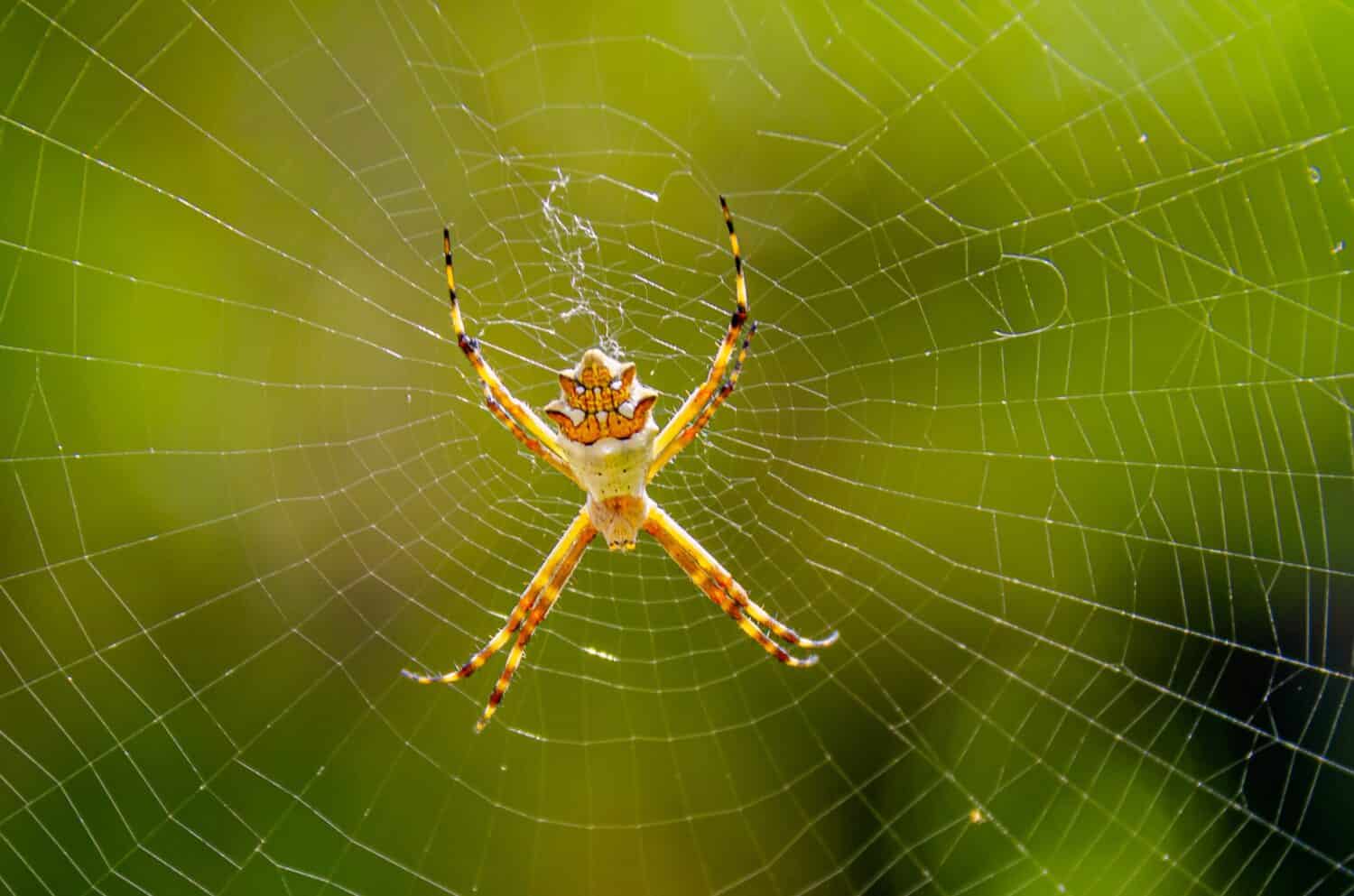
Silver garden spiders build elaborate webs where they hang upside down waiting for prey.
Image: Carlos Campi, Shutterstock
©Carlos Campi/Shutterstock.com
The silver garden spider belongs to the orb weaver family Araneidae. It’s common throughout the southern half of North America. You can normally find these spiders in California gardens, parks, or anywhere else with plants.
The silver garden spider gets its name from the bright silver color on its carapace and legs. Meanwhile, its abdomen is covered in orange, black, and red stripes, while its legs are silver with black and white bands. Specimens measure anywhere from 3 to 16 millimeters long, with females measuring larger than males.
Like other orb weavers, silver garden spiders build ornate webs where they tend to hang upside-down as they wait for prey. Their webs include a distinctive zig-zag pattern and are made of strong, thick silk. While venomous, the bite of a silver garden spider is not threatening to humans.
#5: Noble False Widow
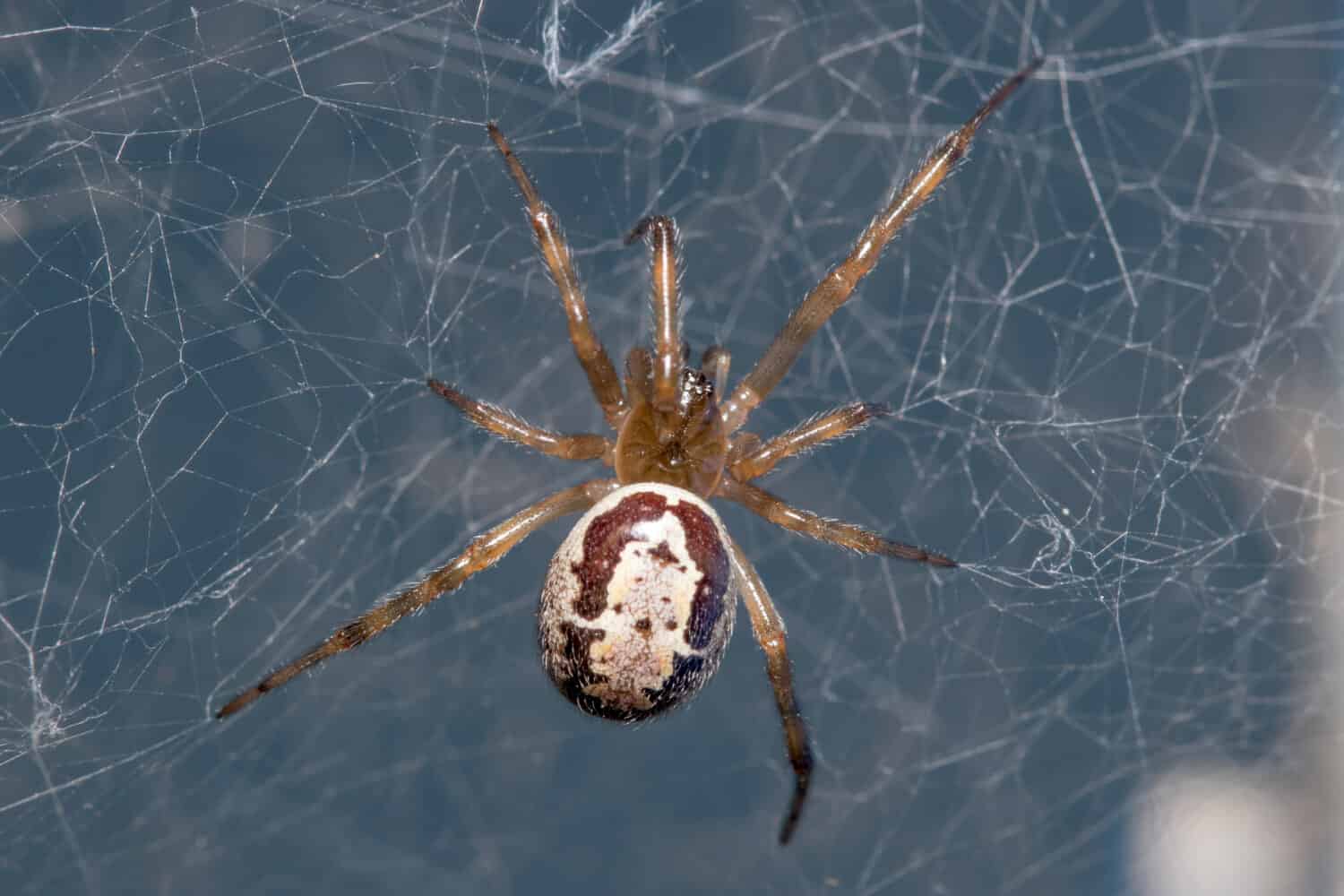
The noble false widow sports a cream-colored skull on its abdomen.
Image: JorgeOrtiz_1976, Shutterstock
©JorgeOrtiz_1976/Shutterstock.com
The noble false widow is a member of the genus Steatoda, whose members go by the name cupboard spiders or false widows. Originally from Madeira and the Canary Islands, noble false widows are now distributed throughout Europe. You can also find these spiders in California, Chile, and Colombia, where it is considered an invasive species.
The noble false widow is the largest false widow spider, with females measuring from 9.5 to 14 millimeters long. Meanwhile, males are smaller, usually measuring 7 to 11 millimeters in length. It is sometimes mistaken for the black widow, although it is distinguishable thanks to the cream-colored marking on its abdomen shaped like a skull.
Noble false widows live both inside and outside year-round and build tangled webs that they use to catch their prey. The bite from a noble false widow is medically significant and can cause pain, redness, and swelling.
#4. Mouse Spider
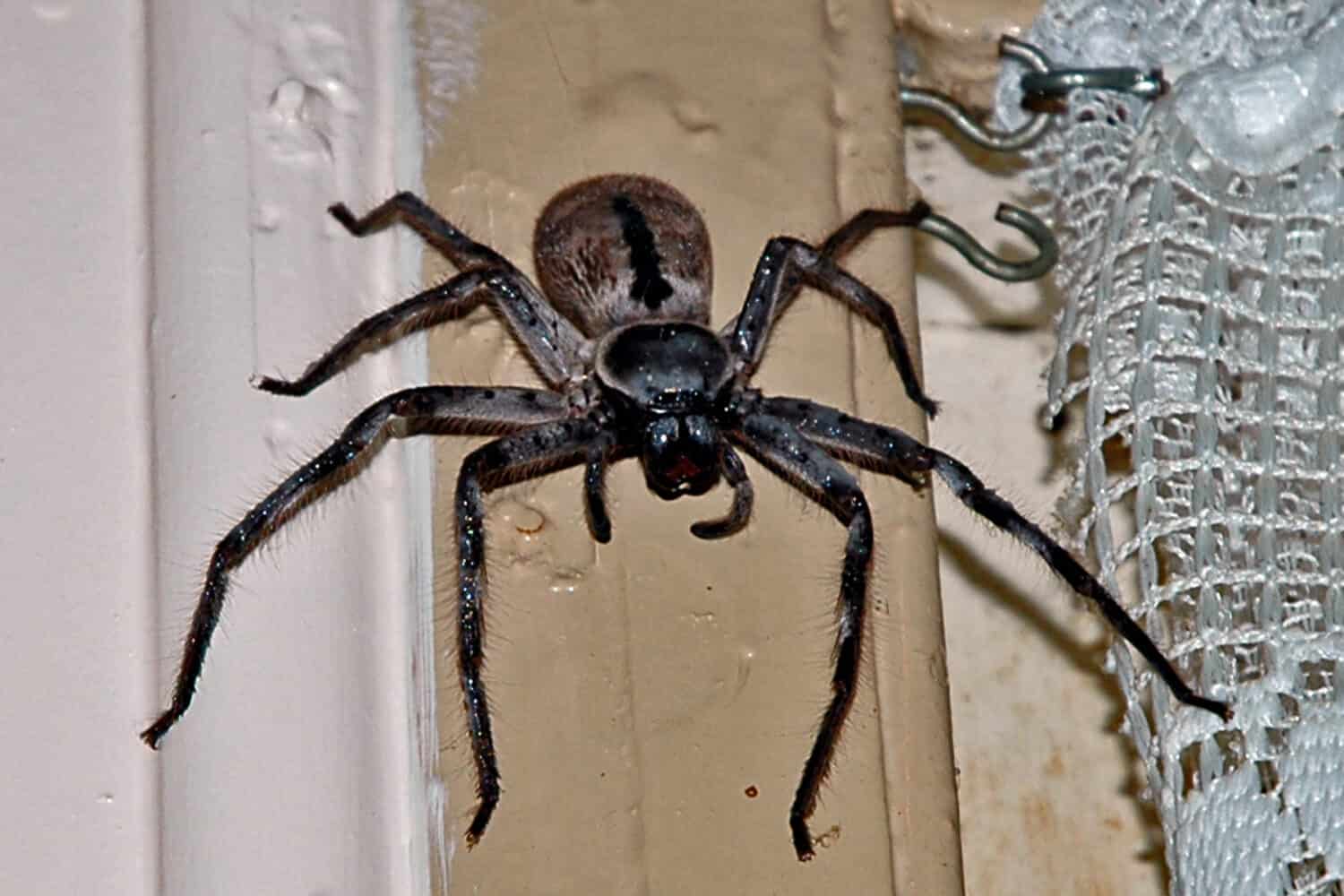
The mouse spider subdues its prey using sticky silk – hunting instead of building a web.
Image: Bob Denelzen, Shutterstock
©Bob Denelzen/Shutterstock.com
Scotophaeus blackwalli, or the mouse spider, is a member of the ground spider family Gnaphosidae. You can find these spiders in California as well as the western United States and parts of Europe. It is not to be confused with the venomous ground spiders of Australia and Chile.
The mouse spider gets its name from its quick, darting movements, which resemble that of a mouse. Its abdomen is predominantly grey and velvety, which also lends it a mouse-like appearance. Females can measure up to 12 millimeters long, while males rarely grow larger than 9 millimeters in length.
Mouse spiders do not build webs, and instead actively hunt for prey, although they will also scavenge for dead insects and spiders. They subdue their prey using sticky silk, a tactic that enables them to tackle larger spiders and insects. Mouse spiders possess weak venom, and their bite poses little danger to humans.
#3. Eared Dome Sheet-Web Weaver
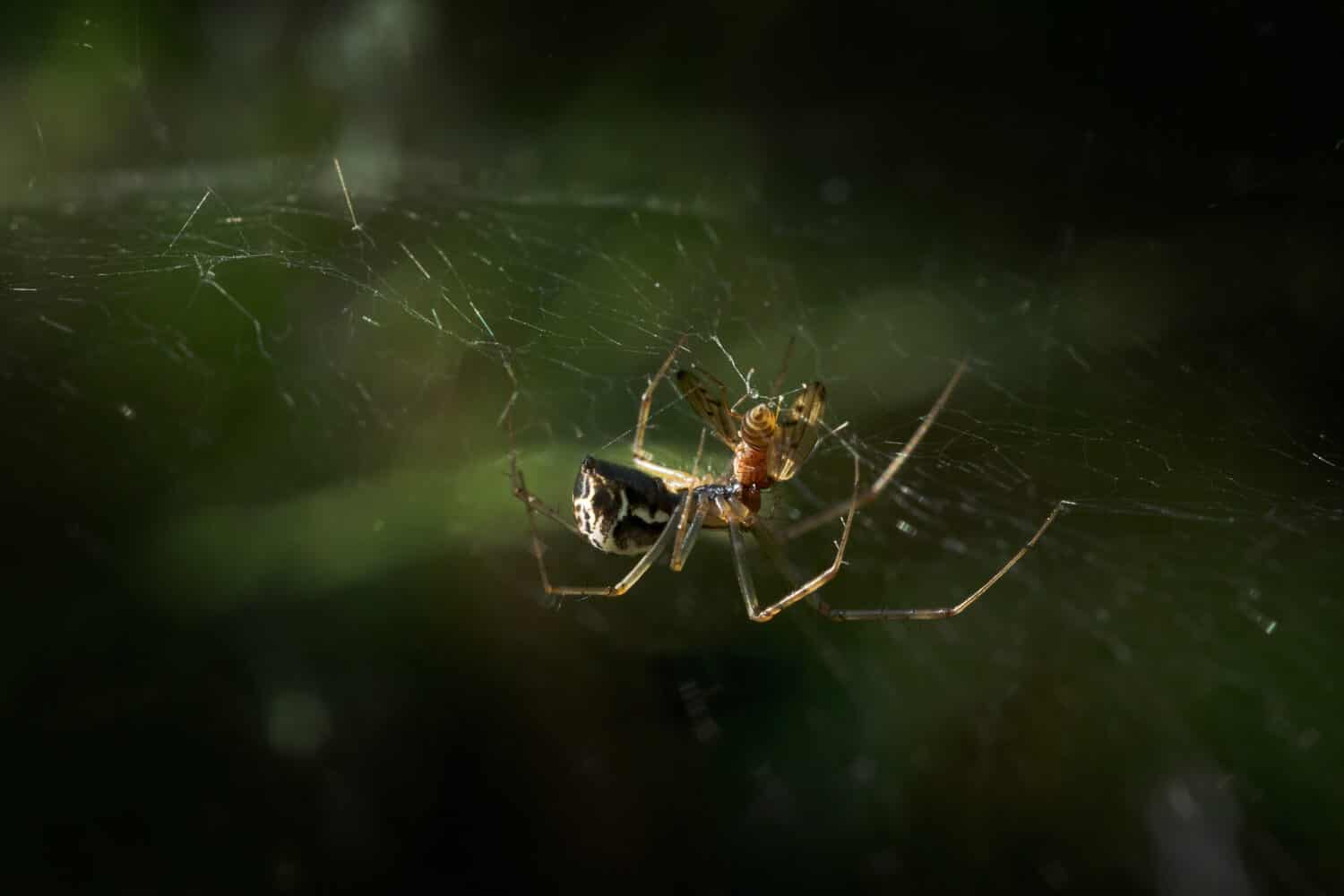
The eared dome sheet-web weaver from markings that resemble ears next to their mouthparts.
Image: Maren Winter, Shutterstock
©Maren Winter/Shutterstock.com
The eared dome sheet-web weaver is a rather inconspicuous and unusually looking species. You can find these spiders in California as well as throughout the western United States. It belongs to the sheet-web weaver family Linyphiidae, which contains more than 2,000 different species worldwide.
Most specimens measure less than 6 millimeters long, with males measuring slightly smaller than females. They get their name from the pair of large disks located near the mouthparts which look like ears. The mouthparts are usually black, while the rest of the body and legs are reddish-brown.
As its name implies, the eared dome sheet-web weaver builds a dome-style web rather than a sheet-style web which is also common in members of its family. Due to its small size, its bite is not considered dangerous to humans, as its mouthparts are not normally large enough to break through human skin.
#2: Tropical Orb Weaver
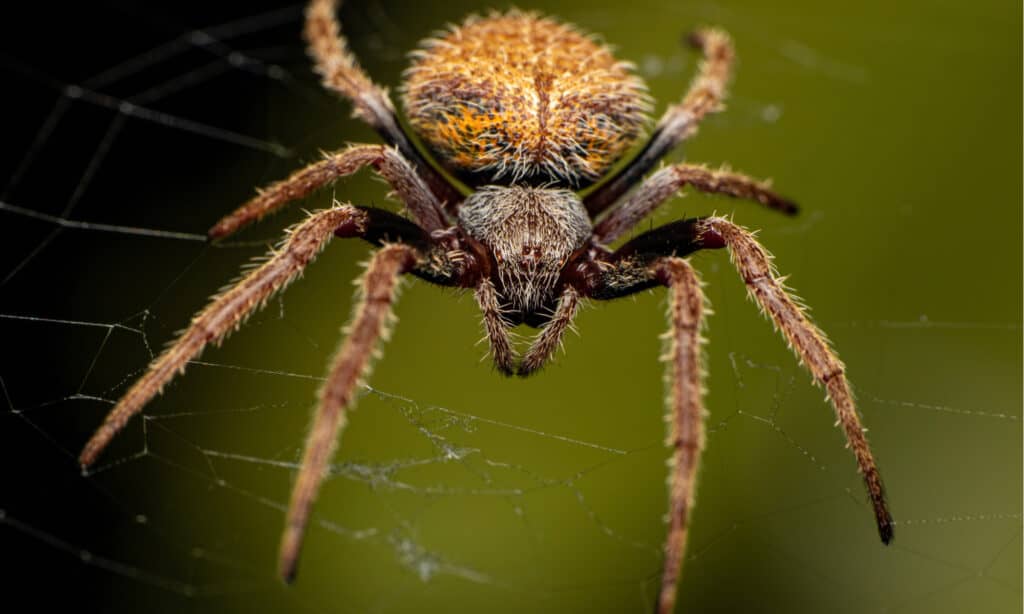
Tropical orb weavers come in a wide variety of bright colors.
©Tommy Daynjer/Shutterstock.com
The tropical orb weaver, eriophora ravilla, is a member of the orb weaver family Araneidae. You can find these spiders in California as well as throughout the southern United States, Caribbean, and Central and South America.
Tropical orb weavers can vary in appearance and come in a range of colors including green, yellow, and orange. Some specimens have a rectangular or diamond-shaped marking on the abdomen, while others have a white stripe down the abdomen. Females can reach up to 25 millimeters in length, while males are usually only half as large.
The tropical orb weaver spins a large, sticky web that it uses to catch prey. During the night, the orb weaver will hang upside down in the middle of the web until unsuspecting prey gets trapped in the silk threads. The bite of the tropical orb weather is harmless to humans but may cause pain or swelling.
#1. California Trapdoor Spider
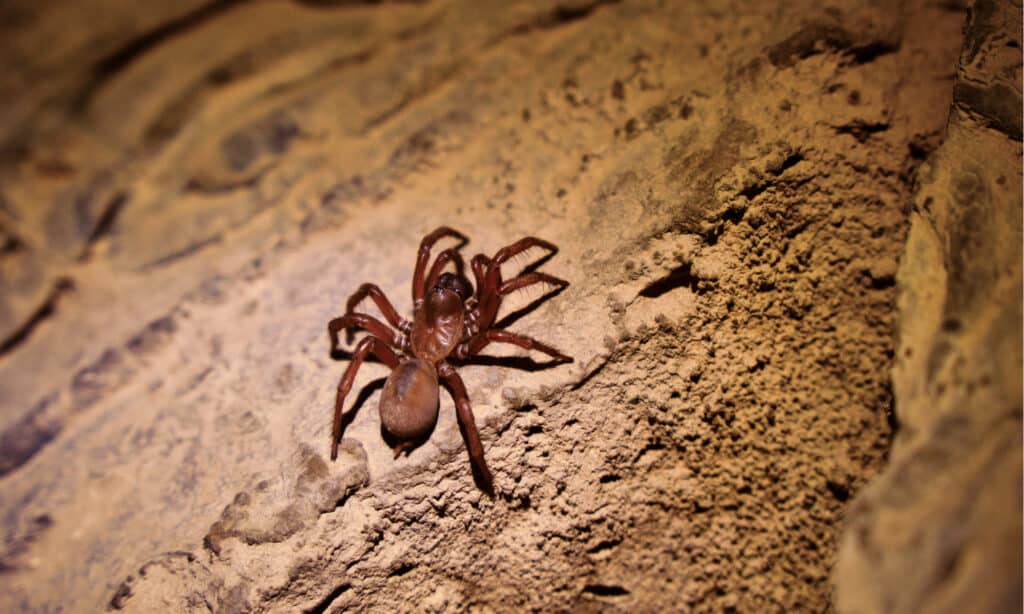
The California trapdoor spider builds a trapdoor on the side of hills or cliffs to hide from its prey and also from predators.
©Geartooth Productions/Shutterstock.com
The California trapdoor spider is a member of the family Ctenizidae and is a native to southern California, which is where it gets its name. They typically build their burrows in hillsides or cliff faces close to vegetation so they have ample access to food.
In appearance, the California trapdoor spider resembles a tarantula. Its body is predominantly black, except for the abdomen, which is reddish-brown. The mouthparts are covered in spines that help it to dig its underground burrow. Most specimens measure between 18 and 33 millimeters long, with females measuring larger than males.
The California trapdoor spider covers its burrow with a silk door behind which it lies in ambush for unsuspecting prey. Once an unsuspecting insect crosses in front of the threshold, the spider will leap out and catch its victim before dragging it into the burrow.
Summary of 10 Spiders in California:
| Name | Size | Web |
|---|---|---|
| California Trapdoor Spider | 18-33 mm | No webs; uses burrows. |
| Tropical Orb Weaver | Females, up to 25 mm; males, half that size | Large, sticky webs. |
| Eared Dome Sheet-Web Weaver | 6 mm | Dome-style webs. |
| Mouse Spider | 9-12 mm | No webs; hunts prey. |
| Noble False Widow | 7-14 mm | Tangled webs. |
| Silver Garden Spider | 3-16 mm | Ornate, zig-zag web pattern. |
| Johnny Cash Tarantula | 15 cm legspan | No webs. |
| Marbled Cellar Spider | 5-7 mm | Curved webs for prey; domed nests for domicile. |
| Buttonhook Leaf-Beetle Jumping Spider | 5 mm | No webs; hunts prey. |
| Hacklemesh Weaver | 6-11 mm | Mesh-like webs; disorganized, asymmetrical. |
The photo featured at the top of this post is © Tommy Daynjer/Shutterstock.com
Thank you for reading! Have some feedback for us? Contact the AZ Animals editorial team.






